Arena Football League (1987-1989)
Tombstone
Born: 1987 – Arena Football League founding franchise
Folded: 1990
First Game: June 20, 1987 (L 52-44 vs. Denver Dynamite)
Last Game: August 11, 1989 (L 43-10 @ Detroit Drive)
Arena Bowl Championships: None
Arena
Rosemont Horizon (14,641)11988 Pittsburgh Gladiators Media Guide
Opened: 1980
Marketing
Team Colors:
Ownership
Owners:
- 1987: Arena Football League
- 1988: Dr. Constantine Tatooles, et al.
- 1989: ?
Attendance
Tilting your mobile device may offer better viewing.
Sources:
- 1988 Pittsburgh Gladiators Media Guide (1987 figures)
- 1999 Arena Football League Record & Fact Book (1988 & 1989 figures, rebuilt from game summaries)
Trophy Case
Arena Football League Most Valuable Player
- 1988: Ben Bennett
Arena Football League Ironman Award
- 1989: Carl Aikens
Arena Football League Coach of the Year
- 1988: Perry Moss
Our Favorite Stuff
Chicago Bruisers
Graphic T-Shirt
The Bruisers were one of four original clubs in the Arena Football League when the innovative indoor football promotion debuted in the spring of 1987. The team would go on to play for three seasons, but due to the AFL’s short schedules and early instability, the Bruisers would play just 11 home games at the Rosemont Horizon during their entire history.
This Bruisers T-Shirt is available from Royal Retros
Background
Jim Foster sketched the concept for Arena Football on the back of a manilla envelope while watching the Major Indoor Soccer League All-Star Game at Madison Square Garden in February 1981. Foster’s idea for a high-scoring, pass happy Frankensport layered a 50-yard carpeted football field over a hockey rink. Teams would play eight-on-eight, with all players except the quarterback playing both ways – offense and defense. There would be no punting and taut 30-foot wide nets placed on either side of the uprights to keep kickoffs, missed field goals and errant passes in play.
Foster commissioned the equipment and staged test games of Arena Football at the Rockford, Illinois MetroCentre in the spring of 1986 and the Rosemont Horizon in suburban Chicago in February 1987. Armed with an ESPN television deal, Foster launched a preview season in June 1987, featuring four league-owned franchises playing a six-game schedule. The four original clubs were the Chicago Bruisers, Denver Dynamite, Pittsburgh Gladiators and Washington Commandos.
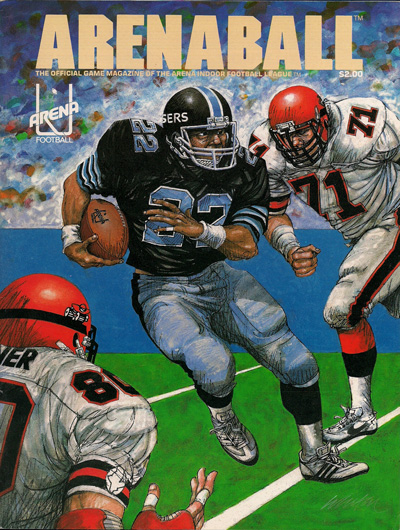
Debut Season
The Chicago Bruisers made their home at the Rosemont Horizon, site of one of Foster’s test games, in early 1987. The Bruisers sold 1,100 season tickets for the 1987 season and debuted at home on June 20th, 1987 against the Denver Dynamite on ESPN. The teams treated the announced crowd of 10,103 to the exactly type of hyperactive end-to-end scoring that Foster envisioned. The Bruisers blew an eight point lead and missed a game winning field goal attempt – all in the final 43 seconds of regulation – before falling 52-44 in overtime.
The 1987 Bruisers roster consisted mostly of NFL training camp castoffs and refugees from the defunct USFL. The most experienced players included NFL and USFL vets Durwood Roquemore, Reggie “Super Gnat” Smith and the kicker Nick Mike-Mayer. Back-up quarterback Sean Payton barely saw the field during his lone season in Arena Football, but would later go on to coach the New Orleans Saints to victory in Super Bowl XLIV. The Bruisers finished the brief season at 2-4, allowing the most points in the league (310) and scoring the fewest (217). The league overall claimed average attendance in excess of 11,000 per game.
Following Arena Football’s 1987 success, Foster sold limited partnerships in his creation to five new investor groups. Arena Football placed expansion clubs in Detroit, Los Angeles, New York City and Providence, Rhode Island. A group of four Illinois businessmen stepped forward as limited partners in the Bruisers, led by Chicago heart surgeon Dr. Constantine “Dino” Tatooles.
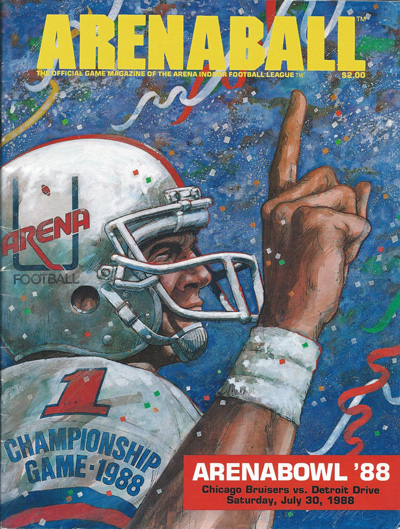
1988: Arena Bowl II
Everything about the 1988 Arena Football League was bigger. The scheduled doubled from 6 to 12 regular season games per team. Player pay increased from $500 per game with a $50 bonus for each win to $1,000 per game with a $150 victory bonus. The 1988 Bruisers surged to a 10-0 start on the arm of Arena League MVP Ben Bennett, who passed for 49 touchdowns in 12 games.
The Bruisers finished the season in first place with a 10-1-1 record and earned the right to host Arena Bowl II on July 30th, 1988. In an unusually low-scoring game, the Detroit Drive defeated the Bruisers 24-13 before 15,018 at the Rosemont Horizon and a national television audience on ESPN.
Ownership Struggles
Following the 1988 season, Foster’s limited partnership structure began to fall apart. For their investment, the limited partners received operating rights to their local franchise. But they held little of the financial and marketing discretion typically accorded to professional sports owners. Player personnel and league marketing decisions remained the domain of Foster, the league’s Commissioner. As Foster, a former United States Football League executive, described it to Sports Illustrated’s Paul Zimmerman:
“We’ve flushed out the big ego guys. We tell ’em ‘look, you don’t own the team, you rent it.’ That gets rid of the Donald Trumps right away.”
Tom Rooney, director of marketing for the Pittsburgh Civic Arena where the league-owned Pittsburgh Gladiators played, gave a different take on the arrangement to The Pittsburgh Press in November 1988.
“You don’t tell someone who puts in millions of dollars how to run their team. Jim Foster was naive. It’s impractical because of the way of human nature and especially the human nature of people who are worth millions of dollars. They don’t throw in millions of dollars and say ‘Jim Foster, you run the league’.”
The limited partners attempted to buy out Foster during the fall of 1988, but he refused to sell. In February 1989, Detroit Drive officials announced to the press that the 1989 season would be cancelled as a result of the dispute. Ultimately, Foster retained control of his creation and most of the limited partners departed. The Los Angeles, New England and New York clubs folded.
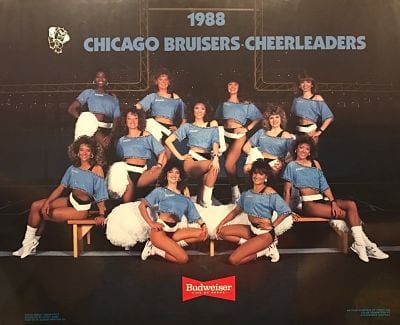
Final Season
Deprived of investors and time, Foster scrambled to put together an abbreviated 1989 season. Games would be co-promoted with arena management companies, rather than franchise investors. The Denver Dynamite and Washington (now Maryland) Commandos were resuscitated to boost the league to five active clubs, possibly because their helmets and uniforms were already in storage from 1987. The league announced plans for what amounted to a barnstorming season. The entire league schedule would consist of just ten regular season games, plus two semi-finals and Arena Bowl III. Each of the five clubs would play four games, appearing only one time in their home city. The remaining five games were scheduled in neutral markets as test games for future expansion opportunities.
Foster slashed player salaries from $1,000 per game to $400 per game in 1989. Many key players returned anyway, including Bruisers quarterback and 1988 league MVP Ben Bennett, Reggie Smith and RB-LB Osia Lewis. Head Coach Perry Moss did not return after leading the Bruisers to a first place record in 1988. He was replaced by long-time Ottawa Rough Riders Head Coach George Brancato.
The 1989 “Chicago” Bruisers made their lone appearance in Illinois on July 7th, 1989 against the Detroit Drive in a rematch of the previous year’s Arena Bowl II. In keeping with the on-the-cheap nature of the 1989 season, both end zones at the Rosemont Horizon displayed the name and colors of the visiting team. To save money on equipment, the league simply shipped Detroit’s carpet surface from city to city. The Drive defeated the Bruisers 40-28 before an announced crowd of 6,662. The Bruisers finished their final season with a 1-3 record.
Aftermath
Jim Foster received a patent for his Arena Football game system in March 1990. Armed with the patent, Foster again began recruiting new investors, this time on a more traditional franchise model, with greater control for local owners. New teams were added in Albany and Dallas and investors came forward for the Denver and Pittsburgh clubs. Local ownership did not step up for the Bruisers. Arena Football announced the termination of the franchise in April 1990.
In August 1990, Chicago attorney Jerry Kurz announced plans to revive the Bruisers for the 1991 Arena Football season. But Kurz’s group failed to pull their financing together. Arena Football revoked the franchise license in March 1991.
Arena Football returned to Chicago and the former Rosemont Horizon, now known as Allstate Arena, in 2001. The Chicago Rush were co-owned by Chicago Bears legend Mike Ditka and played in the original Arena Football League from 2001 until its demise in 2008. A revived, low-budget version of the Rush later returned briefly play in a re-booted AFL but folded for good in 2013.
Chicago Bruisers Video
The 1989 Charles Bronson actioner Kinjite: Forbidden Subjects features an extended sequence shot during an actual Chicago Bruisers Arena Football game played in 1988 against the Los Angeles Cobras at the Los Angeles Sports Arena. This is one of the first depictions of the sport of Arena Football in the broader popular culture.
Downloads
7-30-1988 Bruisers vs. Detroit Drive Arena Bowl II Roster
7-30-1988 Chicago Bruisers vs. Detroit Drive Arena Bowl II Roster
1988 Arena Football League fan survey
1989 Chicago Bruisers Roster & Team Overview
Links
###

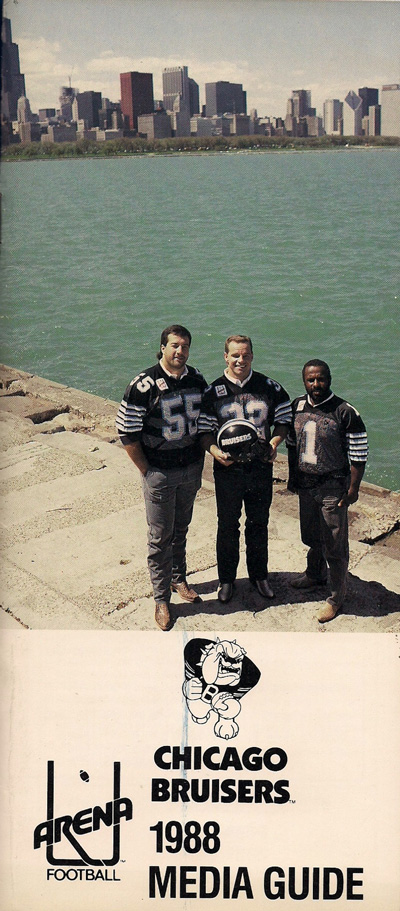
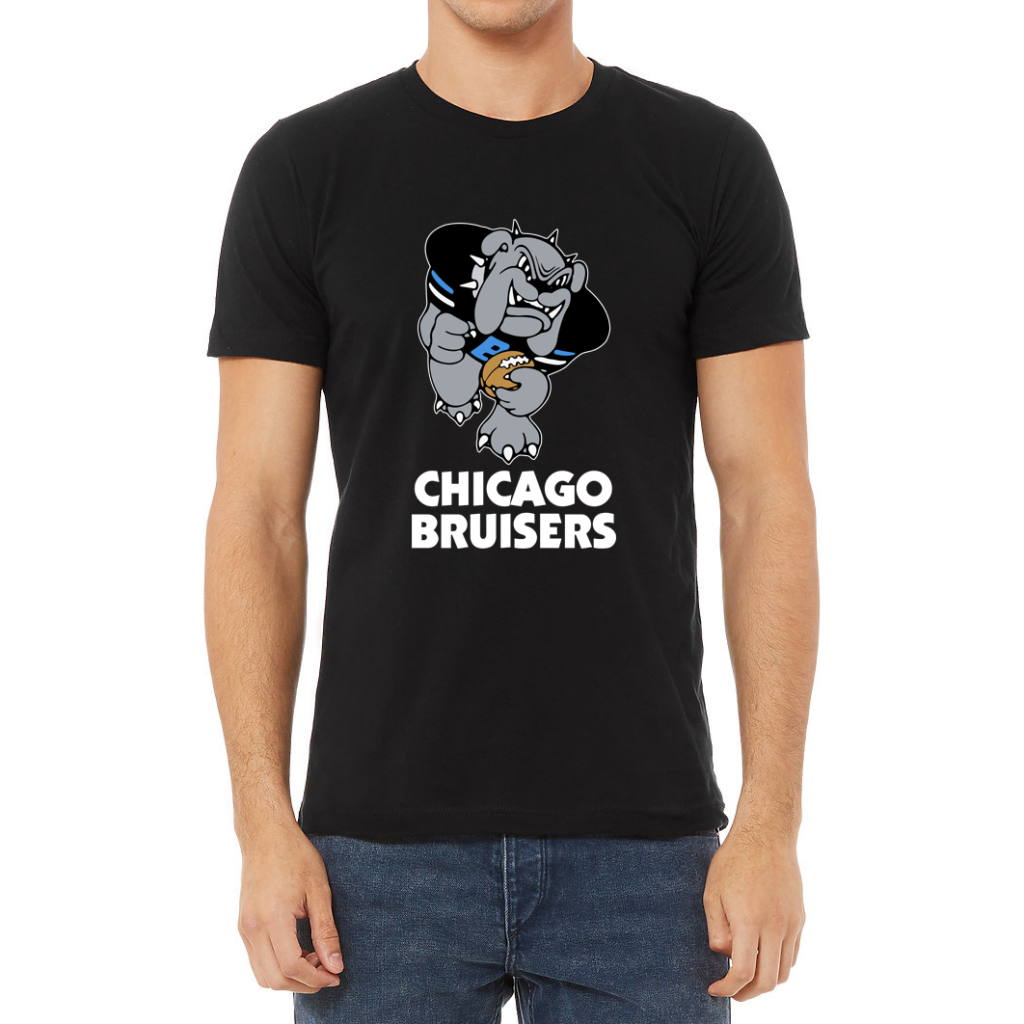
2 Responses
Interesting website. I was an early fan of arena football, traveled to Chicago (from Minneapolis) just prior to the 1987 season on a search for AFL merchandise for a co-worker who part-timed selling sports fan items.
Bought several of whatever was available on the league (memory includes buttons, pennants, stickers and caps, could have been more) and spoke with Jim Foster when I went to the office at the arena looking for more “for sale” material.
Did not know who or what he was at the time, but we talked for some time and I made the error of suggesting that Arena Football could possibly do as well as indoor soccer. I think he was offended.
Anyway, on return to Minneapolis I video taped the first game, Chicago – Denver, and later transfered it to dvd. ESPN made even more mistakes than the players, doing something for the first time and not all that well. But the game was lots of fun.
It’s been years since I watched it myself, but perhaps this evening would be a good time to re-live the experience.
Writing to ask if you would like one of my two dvd copies of that game? Between ESPN’s stumbles and transfer from VHS to dvd the quality is hardly more than adequate, but perhaps you would like to see it. It may already be available though, I sold or traded a copy many years ago to another fan so it may be out there somewhere already.
I was at the first Bruisers game. I saved the scorecard/program for a number of years thinking it would someday be a collector’s item. Don’t think I have it, wish I did. Remember the crowd chanting for Reggie, Reggie. Remember the Bruisers coming from behind only to lose in the last minute.